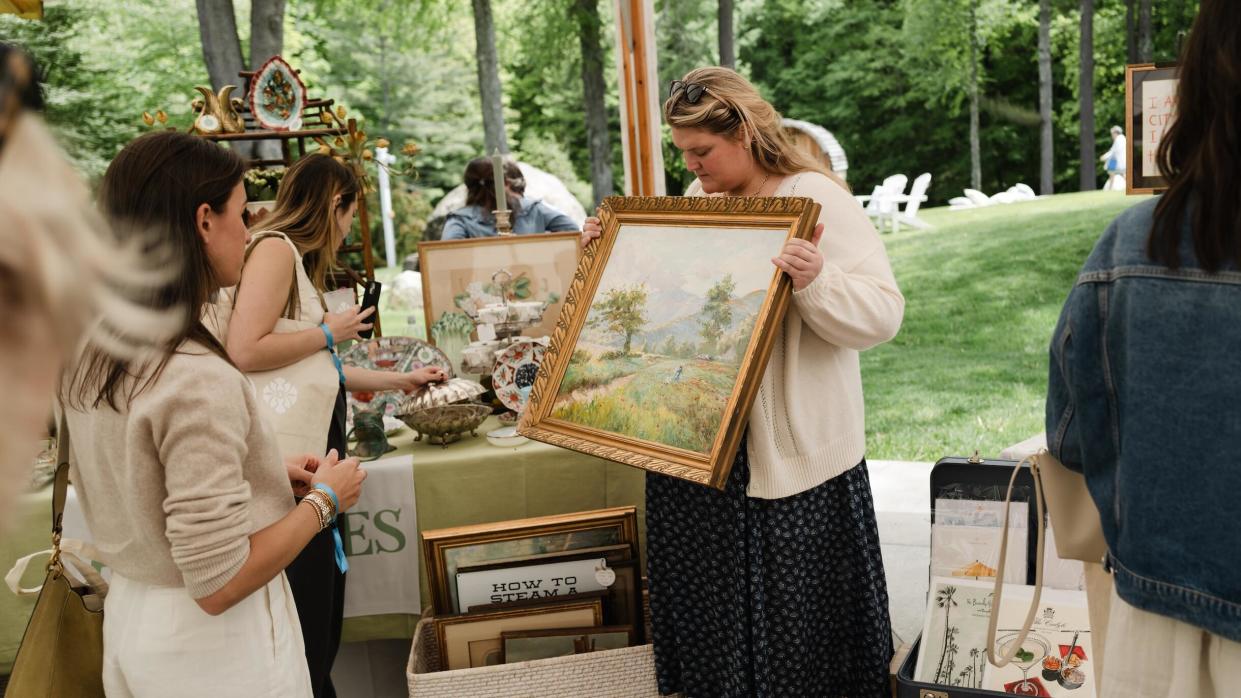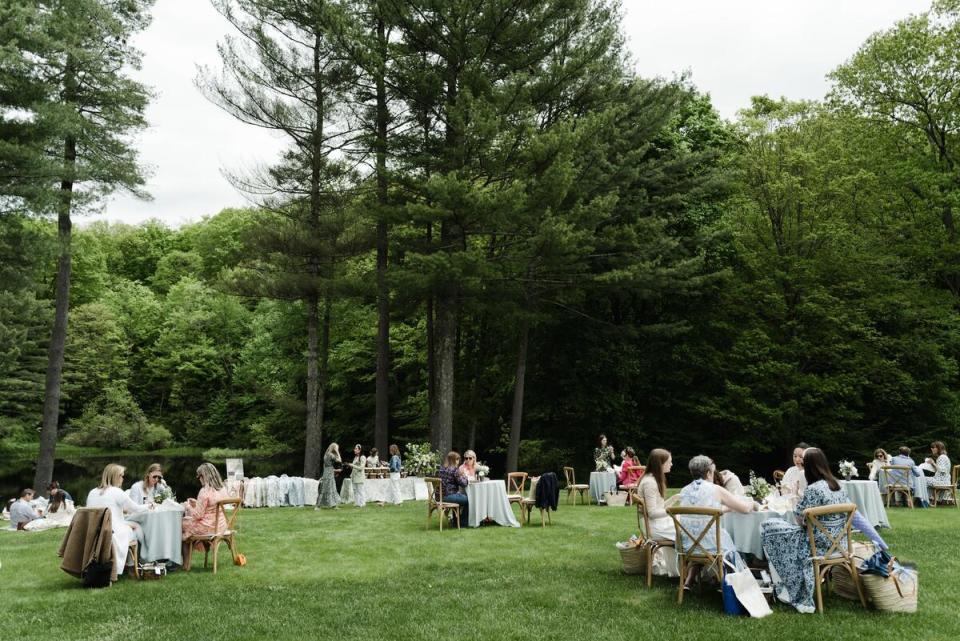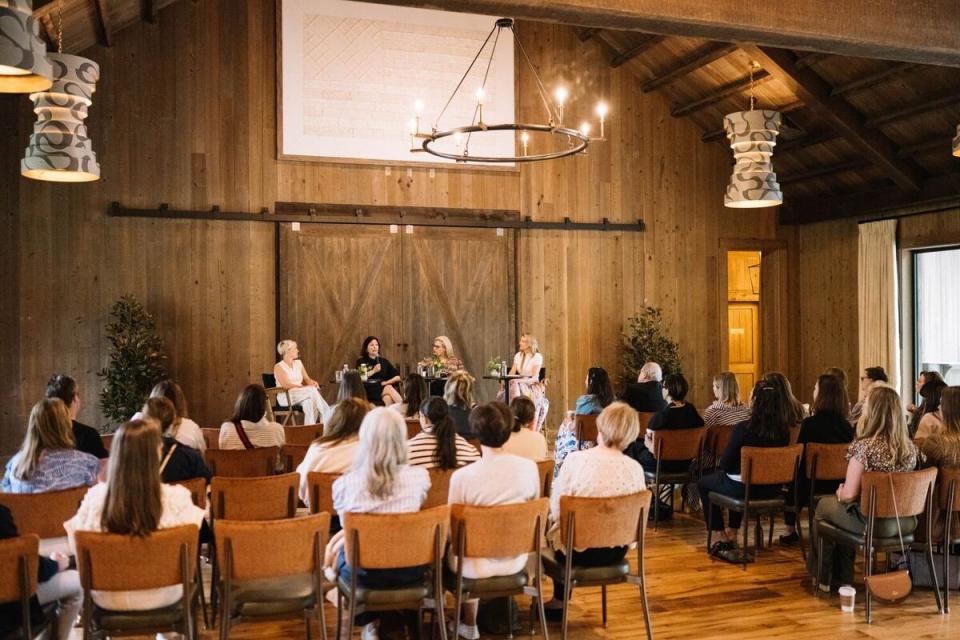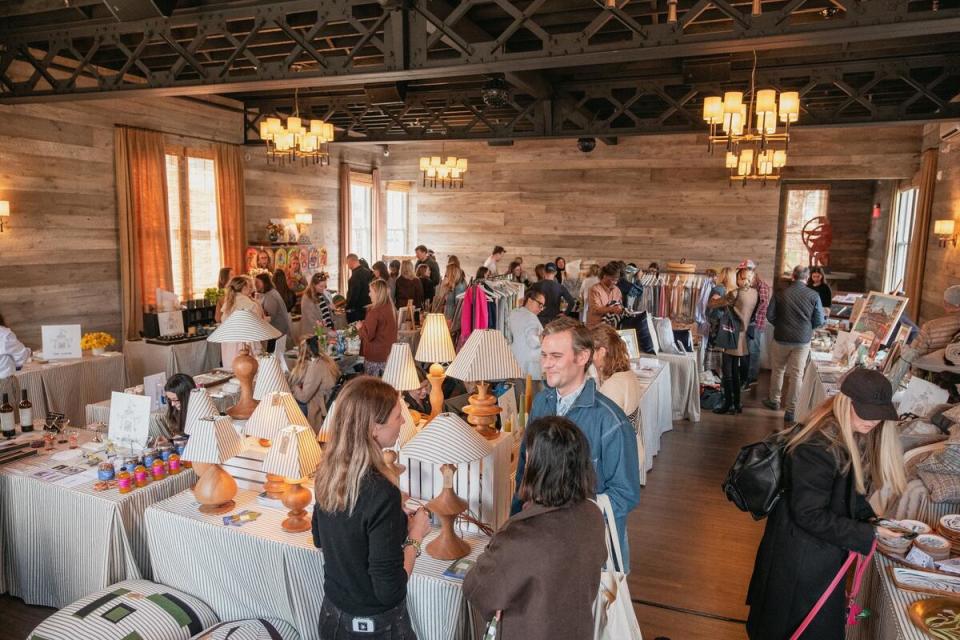Why pop-up design events are on the rise

Weekly Feature | May 22, 2024
For the last few years, designer Ariel Okin has cultivated an online community called Fenimore Lane: a site that blends interior design and lifestyle e-commerce and editorial content. More than a year ago, she began toying with the idea of pulling the whole platform into the real world. It was a big undertaking, but she was certain she could make it work—at least for a few days. “I wanted it to feel as if Fenimore Lane had a country house and was a human person,” she says. “[If] you were coming to stay at their house for the weekend and they were throwing a great party, what would that be?”
Last weekend, Okin answered her own question. At the Mayflower Inn & Spa—an Auberge resort nestled deep in the Connecticut countryside—she hosted the first Fenimore Lane Design Summit: a pop-up with more than 30 home, lifestyle and fashion vendors. With tickets ranging from a $55 shopping pass to a $1,650 VIP overnight package, attendees could experience the brand in real life for the first time.

The event was true to Okin’s expectations: Clad in their summer best, women of all ages spent the day roving around the hotel’s manicured grounds, past towering floral arrangements and into various events and activities, with a constant flow of complimentary champagne or ethically made Grace Farms tea in hand. In each of the summit’s two shopping tents, vendors held court for a meandering crowd of shoppers, serving up high-end dresses, jewelry, children’s clothing, antique decor and stationery. It was a scene straight out of the Fenimore Lane blog: Audrey Gelman presided over a booth for her Brooklyn design shop The Six Bells, and the founder of boutique graphic design and art studio My Father’s Daughter sold illustrations of luxury-hotel matchbooks and keys (a crowd favorite was her sketch on Plaza stationery with the Eloise quote “My mother is 30 and has a charge account at Bergdorf’s”).
In the afternoon, panels presented by Farrow & Ball and Mitzi offered attendees take-home design tips while various activities unfolded elsewhere on the grounds—including a floral arranging workshop, a cocktail making class, a children’s craft section and a book signing with chef and New York Times recipe developer Lidey Heuck. At lunchtime, a pastoral scene played out by the hotel’s pond, where representatives from Lee Jofa laid out newly launched floral fabrics and pillows and handed out picnic baskets of prepacked lunches.
The event was a unique combination of shopping, hospitality and networking—but it wasn’t the only such pop-up to make its debut this spring. Just the week before, luxury resort Blackberry Farm introduced its own Design Summit in Tennessee’s Great Smoky Mountains, featuring industry heavyweights Jim Druckman, Alexa Hampton and Dara Caponigro as keynote speakers. And back in March, The Ticking Tent was raised for the first time, helmed by industry PR veteran Christina Juarez and design editor and stylist Benjamin Reynaert. In some ways, these new festivities build off the tradition already set forth by events like the Design Social Pop-Ups and Design Edge, which harness the same energy and spirit of connection in a trade-only setting for vendor discovery.

These event organizers agree that in some respects, the proliferation of pop-ups is a reaction to the design industry’s fast digital adoption in recent years. According to Juarez and Reynaert, The Ticking Tent was in part a way of offering more convenient in-person sourcing—something they currently see as a void in the market.
“We would get questions from interior designers about, ‘Where do you go to source things? Where are you shopping? What’s interesting?’” says Reynaert. “There are so many interesting artisans and boutique brands online, across the country and in far-reaching areas, and we really wanted to bring everyone together under one tent and make a more curated destination for designers to discover new products and people to work with.”
Inspired by the atmosphere and diversity of offerings at Parisian flea markets, the pair summoned vendors ranging from big brands like Benjamin Moore and Schumacher to antiques purveyor Larger Cross and artist Amy Carson Smith. They also tapped interior designers with warehouses full of stockpiled treasures to present pieces for sale.
Aside from day-of sales, the event sparked new ongoing industry connections among vendors and attendees. Several regional stores set up wholesale accounts with new distributors, artisans were commissioned by designers to create new custom pieces—and the show even led to the creation of another pop-up, by decor and gift brand The Grey Pearl and fashion line The Salting.
“Because they have online businesses, a lot of these artisans don’t get to interact in a brick-and-mortar setting with [shoppers],” says Juarez. “This event may be one day, but the relationships that these artisans nurture with the designers who bought their goods that day—they’re still in touch.”
Beyond making space for design industry connections, the pop-up format also provides a unique opportunity for community-building. For the Fenimore Lane Summit, Okin aimed to cultivate a 50-50 mix of trade and everyday consumers, betting that the crossover would incentivize members of both circles to come out.
“So much of the design industry is siloed online,” says the designer. “There are a lot of people who know each other from Instagram but haven’t met in real life. It’s so nice post-Covid to go to an event and have a cocktail and mingle.”
Accordingly, the event ended up hosting a mix of attendees from both groups—ranging from local designers, real estate agents and design professionals who flew in to meet up with industry connections, to mother-daughter duos and girls trips. “You can’t see a lot of this stuff in person, so to be able to see everything and meet everyone—it’s so nice,” says lifestyle influencer Jen Gummere, who purchased the overnight package with her sister.

The right setting plays a key role in a pop-up’s success too—the Mayflower Inn has long been a favorite destination among the design community jet set, while Blackberry Farm has deep design roots and a dedicated team committed to the hotel’s interiors (and those of the private homes on its estate, which are available for purchase). For that reason, proprietor Mary Celeste Beall says holding a design summit was a no-brainer. “For every room and every space, the design and the function and the look are so much a part of the feeling of Blackberry,” she says.
Aside from shared design revelry—the team put together a three-day event ($1,200 per ticket, plus room fees), complete with panel discussions, curated group meals and tours of the estate’s private homes—Beall says it was a chance for professionals to compare notes among a like-minded crowd.
“I also think that the thing everyone was so excited about was how much they learned from one other,” she says. “They were asking each other questions about different ways that they run their businesses, really sharing best practices. That collaborative, cooperative, think-tank feeling was something that people weren’t expecting.”
All three of the new pop-ups will be back next year—and some even sooner than that. The Ticking Tent is planning its next edition for the fall, this time in search of a larger space to accommodate more artisans and vendors and potentially an early-bird shopping hour. The Blackberry Farm design event is also attempting to nail down 2025 dates and allow for more attendees, and The Fenimore Lane Design Summit plans to return next year as a three-day event with more programming. The organizers agree that their success is not an indictment of online design, but a reminder that the power of an in-person event is not something to be overlooked—even if it’s in small doses.
“Obviously there’s so much we can learn and be exposed to online,” says Beall. “But there’s just nothing that beats in-person connection, face-to-face.”
Want to stay informed? Sign up for our newsletter, which recaps the week’s stories, and get in-depth industry news and analysis each quarter by subscribing to our print magazine. Join BOH Insider for discounts, workshops and access to special events such as the Future of Home conference.

